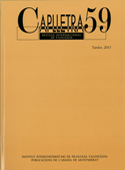Diachrony and neology: semantic change, subjectivization and the representation of thinking. The meaning of the Catalan verb "esmar", from ‘setting the price of’ to ‘inferring’ and ‘imagining’ and beyond
DOI:
https://doi.org/10.7203/caplletra.59.6909Keywords:
Diachronic semantics, inference, subjectivization, evidentiality, pragmatics, semantic change Abstract
Abstract
Abstract: The study of neology is inextricably linked with the study of language change and, therefore, with diachrony. The aim of this paper is to describe the semantic change process undergone by the Catalan verb esmar, which is the etymological form of the Latin verb *ADAESTIMARE, parallel to the Latinism estimar. This research is corpus-based, using large corpora along with other manually processed materials. The concepts of subjectivation and inferences according to the Invited Inference Theory of Semantic Change (IITSC) have been applied to these materials. Key words: Diachronic semantics, inference, subjectivization, evidentiality, pragmatics, semantic change.
 Downloads
Downloads
Downloads
Published
How to Cite
-
Abstract759
-
PDF (Català)403
Issue
Section
License
Authors submitting work to Caplletra for publication must be the legitimate holder of the usage rights. Legitimacy for the purposes of publishing the work must also include images, tables, diagrams and any other materials that may complement the text, whether they are the author of such material or not.
Copyright: on publishing their work in the journal, the author grants Caplletra. Revista Internacional de Filologia usage rights (reproduction, distribution and public communication) for both the paper printed version and for the electronic version.
All work published in Caplletra is covered by the Creative Commons license type Attribution-NonCommercial-NoDerivatives 4.0 (CC BY-NC-ND 4.0).
RESPONSABILITY
Caplletra. Revista Internacional de Filologia does not necessarily identify with the points of view expressed in the papers it publishes.
Caplletra. Revista Internacional de Filologia accepts no responsibility whatsoever for any eventual infringement of intellectual property rights on the part of authors.






